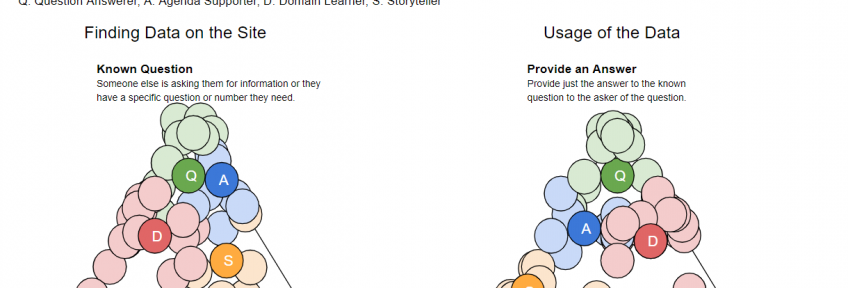The Natural Resources Revenue Data (NRRD) portal provides open data to the public about revenue generated from extraction of natural resources on public lands and waters. Open data provides transparency into government operations, which gives the public information to back up claims made in the name of social justice. To make our data truly open and useful to the public, we’re going beyond our government mandates to open data and including our users in the design process as our site evolves.
Innovation Summary
Innovation Overview
The Problem
In 2012, the U.S. Department of the Interior’s Office of Natural Resources Revenue (ONRR) was tasked with implementing the Extractive Industries Transparency Initiative (EITI), which is an international initiative to promote transparency into the flow of money from the extraction of natural resources. In accordance with this initiative, the agency created the Natural Resources Revenue Data (NRRD) portal (https://revenuedata.doi.gov/) that provides open data to the public about revenue generated on public lands from the extraction of natural resources. It was initially designed to be an interactive version of the annual report required by the initiative and largely designed to meet the requirements for that report.
In 2017, the U.S. withdrew as an EITI implementing country, but ONRR made a commitment to continue in the spirit of the initiative. That, along with a renewed presidential mandate to employ data and improve customers’ experiences with government services, have allowed our team to rethink the site and shape it to truly meet user needs.
Goals of The Innovation
Now that our core focus has shifted from meeting specific EITI requirements to meeting the needs of the people who use our site, we have amplified our efforts to understand who uses our site and are discovering how they use the data.
We’ve discovered that our users differ most in two primary areas: how they find data on the site and how they use the data after they find it. They fall into four primary user types: Question Answerers, Agenda Supporters, Storytellers, and Domain Learners.
Once we started learning more about our site’s users, we rewrote our product vision to help guide our work:
“We are informing policy debates and raising public awareness by building the definitive source of timely and useful data about how the government manages federal energy and mineral resources, revenue, and disbursements.”
The Innovation
One implemented innovation that has come from this new focus is our new homepage. Some have argued homepages aren’t as important as they used to be. The increased use of search and social media to convey users deeper into websites is evident, but most users we talked with still use our homepage as their primary starting point and our analytics show it’s the most visited page on our site, with 22% of site sessions in 2018.
Equipped with the knowledge that our homepage was valuable to our users, we set about prototyping and testing options with users to determine how it could better serve the needs of users. In addition, we were getting requests from users who fall into our “domain learner” and “question answerer” user types asking for summarized numbers on the homepage so they wouldn’t have to dig through the Explore Data page to find them. We tested 6 options with users matching a variety of user types and narrowed them down to 2.
In the second round of testing, we included new users to make sure our additions didn’t scare away those without a basic understanding of the data. In addition, we tested with more domain learners to make sure we were meeting their needs. We learned that we needed to better explain the production, revenue, and disbursement process and landed on the best approach for the new summary information on the homepage.
We then tested 3 concepts with additional content at the top of the homepage to explain how the different pieces of data work together. We landed on one concept that worked best and also learned that general-public users are most likely to use the site to explore data related to their geographic area, so the map needed to come before the new summary information on the homepage.
These three studies led us to the design we built. It better explains the process behind the data to those who are not intimately familiar with the subject matter, while also providing high-demand, summary data to domain learners and question answerers. Based on the findings from these studies, we also plan to simplify the structure and navigation of the Explore Data page and make it easier to understand how to interpret and use the data.
Who Benefits
The American people collectively own federal lands, waters, and the minerals beneath them. Transparency about how these resources are managed is crucial to public discourse and government accountability. However, data about public resources is underutilized because it often lacks context or is presented in ways that aren't readily accessible or understandable to users. We are changing that with our focus on user-centered design.
The Future
Now that we have a commitment to designing the site using user-centered design processes, we will continue to evolve based on learnings from user research. We are also committed to sharing user-centered design practices throughout our agency and have already begun by cross-training our colleagues and providing consultations to other work groups across our organization.
Innovation Description
What Makes Your Project Innovative?
We’re going beyond the mandate to open data to discover what the public really wants and needs to do with the data and make it easy for them to accomplish those goals. Our team follows user-centered development practices and a hypothesis-driven design and development cycle to make government data truly open to the public. This shift away from the Extractive Industries Transparency Initiative (EITI) and their annual reporting requirements ultimately represented an opportunity for ONRR to revisit and sharpen the goals of the site to help us respond more directly to user needs. This is the first data portal of it’s kind within the U.S. Department of Interior.
We’re also fostering a culture of innovation at ONRR by spreading user-centered design processes to other projects within the agency. The Department of the Interior is actively working to make the open source and open data practices that support the website a regular part of working protocol, which hasn’t been done before.
Innovation Development
Collaborations & Partnerships
We collaborate with people from a number of groups within our agency and other DOI agencies (such as the Bureau of Land Management and Bureau of Ocean Energy Management) to retrieve the data we use on our site. We also have partnerships with a number of our site’s users including journalists, activists, academics, data aggregators, and state, county & tribal officials who we collaborate with when working on new designs.
Users, Stakeholders & Beneficiaries
We’ve discovered our users differ most in how they find data on the site and how they use the data after they find it. They fall into four primary user types: Question Answerers (government officials, Congressional staffers) who answer questions using the data; Agenda Supporters (NGOs) who support a cause, Storytellers (journalists) who tell stories about the data, and Domain Learners (state and tribal leaders) are decision makers and care about a specific domain, such as a geographic area.
Innovation Reflections
Results, Outcomes & Impacts
In addition to the users who participated in the prototype studies, we’ve shown the new homepage to users who participated in previous user research studies and they reacted positively to the improvements saying that it’s much better at explaining the purpose of the site and getting them to data faster than it was before the redesign. Unfortunately, we don’t have a good way to quantitatively track some of the improvements because our analytics are currently missing the ability to track clicks within a page and our site relies heavily on anchor links. Visits to the homepage have increased 1.3% since the homepage went live.
Challenges and Failures
Since we have a very unique audience, one challenge we’ve encountered is finding our users. Government rules prevent us from providing incentives to research participants, so we’ve had to get creative and do a lot of outreach work with the public.
Another challenge was adapting the site to meet the needs of internal users of a decommissioned site that used to allow them to filter data they wanted to view and download. We’ve learned that the portal doesn’t have all of the same data available and doesn’t meet the needs of those users who want to slice and dice the data. We’re adding filterable tables to the site that will meet the needs of these users as well as some of our other user types.
We also have a limited team because our technically experienced team members are limited to 2-4 year terms, so they’re working to train permanent staff in their skill sets and figuring how to make the site sustainable with limited technical skills.
Conditions for Success
NRRD relies on ONRR leadership support so we must continue to contribute towards ONRR and DOI’s mission and build coalitions across the organization. As interest grows and we continue to add data to the site, we must adhere to the product scope and stay responsive to user needs. We need to continuously work to minimize technical debt and avoid becoming a legacy system by dedicating resources to hardware, software and appropriate technical training within ONRR. We need to continue to perform outreach and advocacy across the department to create the relationships necessary to receive/solicit data and support from our colleagues.
Replication
Our goal is to be a model for other groups who want to make open data useful. So often, open data is made available without thinking out who is using it and how they are using it.
As an open source website, all of our work is transparent and able to be replicated by anyone. We also document and share all of our user research studies and results, maintain a blog aimed at a technical audience, and are active on social media and at conferences.
Our website is the first of it’s kind within the U.S. Department of Interior, but we are working to foster a user-centered design culture across our organization by providing consultations and trainings and inviting colleagues to participate in our user research. Our approach is slowly being instituted across the U.S. federal government and is supported by mandates at the highest level.
Lessons Learned
So far, we’ve determined a few best practices that should apply to other open data sites:
· Know and listen to your users.
· Present the data in ways that facilitate understanding.
· Try not to introduce bias in the way the data is displayed.
· Give users control over the data, so they can slice it to get at the specific piece of information they need.
Anything Else?
The portal was originally developed for USEITI, which was part of the Open Government Partnership.
I emailed an image that wouldn't upload to [email protected]. Here's the alt text for that image: final design with new process at top, map, and new summary information
Date Published:
20 May 2019

